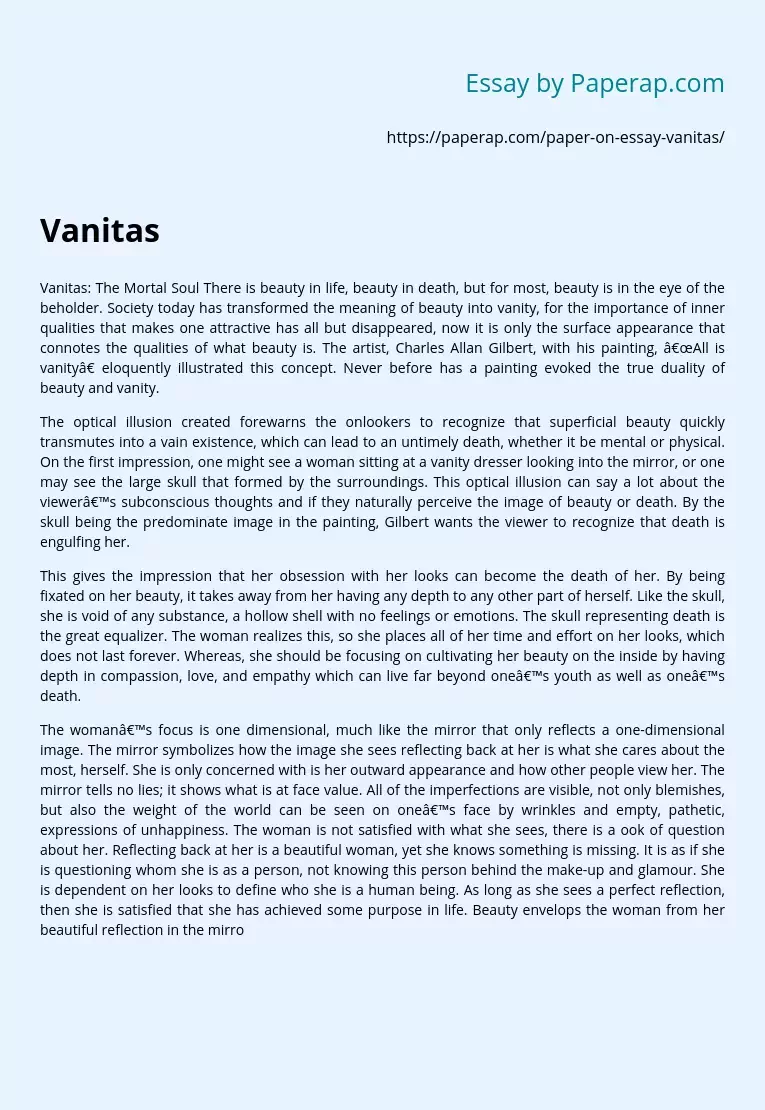Vanitas: The Mortal Soul There is beauty in life, beauty in death, but for most, beauty is in the eye of the beholder. Society today has transformed the meaning of beauty into vanity, for the importance of inner qualities that makes one attractive has all but disappeared, now it is only the surface appearance that connotes the qualities of what beauty is. The artist, Charles Allan Gilbert, with his painting, “All is vanity” eloquently illustrated this concept. Never before has a painting evoked the true duality of beauty and vanity.
The optical illusion created forewarns the onlookers to recognize that superficial beauty quickly transmutes into a vain existence, which can lead to an untimely death, whether it be mental or physical. On the first impression, one might see a woman sitting at a vanity dresser looking into the mirror, or one may see the large skull that formed by the surroundings. This optical illusion can say a lot about the viewer’s subconscious thoughts and if they naturally perceive the image of beauty or death.
By the skull being the predominate image in the painting, Gilbert wants the viewer to recognize that death is engulfing her.
This gives the impression that her obsession with her looks can become the death of her. By being fixated on her beauty, it takes away from her having any depth to any other part of herself. Like the skull, she is void of any substance, a hollow shell with no feelings or emotions. The skull representing death is the great equalizer.
The woman realizes this, so she places all of her time and effort on her looks, which does not last forever. Whereas, she should be focusing on cultivating her beauty on the inside by having depth in compassion, love, and empathy which can live far beyond one’s youth as well as one’s death.
The woman’s focus is one dimensional, much like the mirror that only reflects a one-dimensional image. The mirror symbolizes how the image she sees reflecting back at her is what she cares about the most, herself. She is only concerned with is her outward appearance and how other people view her. The mirror tells no lies; it shows what is at face value. All of the imperfections are visible, not only blemishes, but also the weight of the world can be seen on one’s face by wrinkles and empty, pathetic, expressions of unhappiness. The woman is not satisfied with what she sees, there is a ook of question about her. Reflecting back at her is a beautiful woman, yet she knows something is missing. It is as if she is questioning whom she is as a person, not knowing this person behind the make-up and glamour. She is dependent on her looks to define who she is a human being. As long as she sees a perfect reflection, then she is satisfied that she has achieved some purpose in life. Beauty envelops the woman from her beautiful reflection in the mirror, to the fine clothes she wears, and the exquisite furnishings about the room.
Ultimately, the woman symbolizes how being shallow and superficial leads to unhappiness and a lonely existence. What she desires in life will never become a reality because she lives a facade. The woman has a distorted view of beauty, even though she is beautiful she constantly searches for faults to fix. The beauty has turned to vanity since obsessions are never ending. Her beauty has caused her to become vain which creates a black heart on the inside, for the more energy spent on the superficial beauty, the less energy is spent on creating inner beauty.
Vanitas: Life, Death, and Beauty Perception. (2019, Jun 20). Retrieved from https://paperap.com/paper-on-essay-vanitas/

